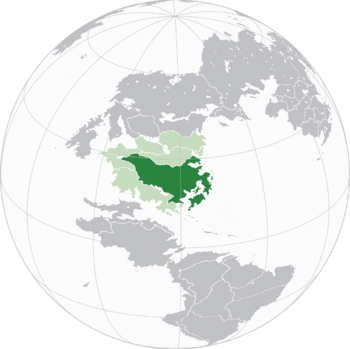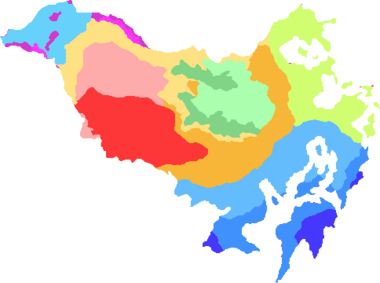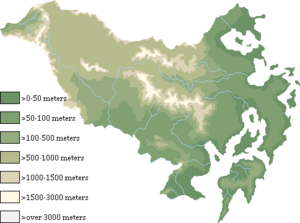Federated Fire Territories
This article is incomplete because it is pending further input from participants, or it is a work-in-progress by one author. Please comment on this article's talk page to share your input, comments and questions. Note: To contribute to this article, you may need to seek help from the author(s) of this page. |
Federation of Fire Territories Fēderæt Fȳrēþel | |
|---|---|
| Motto: “Eftārīsan fram þās æsces.” "Rise again from these ashes." | |
 Fȳrēþel & Erecg-Wīnya | |
| Capital | Nīwe-Fȳrhēafodstōl |
| Largest city | Brēcænburg |
| Official languages | Fēþisc; Isætinyan |
| Recognised regional languages | Īweric |
| Ethnic groups | 76% Fȳrfolc 16% Bēnirani 5% Īweri 3% Other |
| Demonym(s) | Fȳrfolc |
| Government | Federal Constitutional Monarchy |
• Monarch | Æþelric XIII |
| Establishment | |
• Dǣd Gēmunglic be Fȳr (Lit: Nuptial Deed in Fire) | 1001 |
• Forma Dōþ of Annes (Lit: First Acts of Union) | 1203 |
• Ōðer Dōþ of Annes (Lit: Second Acts of Union) | 1487 |
| Area | |
• Total | 3,144,588.21 km2 (1,214,132.30 sq mi) |
| Population | |
• 2018 census | 277,467,426 |
• Density | 88.24/km2 (228.5/sq mi) |
| GDP (PPP) | estimate |
• Total | $6,496.11 billion |
• Per capita | $22,830 |
| GDP (nominal) | estimate |
• Total | $4,925.03 billion |
• Per capita | $17,750 |
| HDI (2018) | 0.804 very high |
| Currency | Fȳrpund (FTP; Ꞩ) |
| Date format | dd/mm/yyyy |
| Driving side | right |
| Internet TLD | .fyr |
The Fire Territories, officially the Federation of Fire Territories but more commonly known as Fire-Land, is a sovereign country on the continent of lower Vinya, in Septentrion. It is bordered by Tír Ealga to the north, Bēnirani in the south, Crioch Fuinidh and Tīri-Ēra in the west.
Fȳrēþel is a federal parliamentary democracy and constitutional monarchy. The current monarch is Æþelric XIII, who has reigned since 2005. Fȳrēþel's capital city is Nīwe-Fȳrhēafodstōl, but not its largest; Its largest city is Brēcænburg, a global city and industrial centre with a population of 13.5 million. The Greater Brecanburg area (Fēþisc: Swīþlic Brēcænburgsetl) is the most populous metropolitan area in the world with over 40 million people. Other major urban areas in Fȳrēþel include Fæstēah, Nīwe-Fȳrhēafodstōl, Clorēþsted, Adlertūn and Hātaþurg.
Fȳrēþel is a developed country and has the world's fourth-largest economy by nominal GDP and fourth-largest economy by purchasing power parity. It has a middle-income economy and has a high Human Development Index rating.
Etymology
Prior to 1203 the 18 kingdoms under the Fire-Empire (Fēþisc: Ᵹiſæti-Isæti) monarchy were formally known as the Fȳrcynerīce; Colloquially known as the "Fire Kingdom". This name would stand until 1203.
The 1203 First Acts of Union (Fēþisc: Forma Dōþ of Annes) declared that the then 21 kingdoms of Lower-Vinya (Fēþisc: Erecg-Wīnya) were "United into One Kingdom under the name of the Fire Territories". The Second Acts of Union (Fēþisc: Ōðer Dōþ of Annes) in 1487 brought the newly purchased island chains of Irēlandes and Geoirēlandes into the union, forming the Fȳrēþel of Erecg-Wīnya ac Ofersǣþel; Colloquially known as the "Fire Territories" or "Fire-land".
The adjective "Fȳrisc" (Lit: Firish) is commonly used to refer to matters relating to Fȳrēþel. The adjective can also refer to the native Wīnya (Lit: Vinyan) language also referred to as Isætinyan (Lit: Isatinyan); Which can trace its origins to the neighbouring country Bēniran.
The adjective "Fȳrfolc" (Lit: Fire-folk) can be used to refer to several major ethnic groups which make up the modern populous of Fȳrēþel.
In other languages of Septentrion
| Sylvan | Letnian | Anglian | Dayashinese | Shinasthana | Īweric | Serenoran | Jedorian | Katmiesie | Sebrenskiyan | Menghean |
|---|---|---|---|---|---|---|---|---|---|---|
| "Tierra del Fuego" | "Фырулия" "Fyruliya" |
"Fire Territories" | "フィレァンヅ" "Fiyaruandu" |
"番閼" "Pur-lan" |
"Tír na Tine" | "Teracocodrila" | "Gaisro žemė" | "Vuurland" | "Požariya" | "희르란드" "Hyirŭrandŭ" |
History
See also: History of Lower-Vinya
Background
Settlement by anatomically modern humans of what was to become Fȳrēþel occurred in waves beginning by about 10,000 years ago. By the end of the region's prehistoric period, the population is thought to have belonged, in the main, to a culture termed Insular Niranic, comprising Niranic Bēniran and Pemīmī Tērī-Tēra. The Niranic conquest beginning in 205BCE, and the 800-year rule of Erecg-Wīnya (Lit: Lower-Vinya), was followed by Fēþfolc (Lit: Walking-folk, Ostlandic Eisenmaton traders & settlers), reducing the Niranic area to mainly what was to become Bēniran. Until the later stages of the Fēþfolc settlement, the inner corners of Erecg-Wīnya would remain largely Niranic.
In 1002, the Nīwe-Fȳrfolc (Lit: New-Firefolk) crown and their allies invaded the largely Fēþfolc kingdom of Fieryrþling, after a Nuptial contract named Dǣd Gēmunglic be Fȳr (Lit: Nuptial Deed in Fire) was signed at the marriage of a Norþfȳrdomne to a Sūþfȳrhlǣfdīge (Lit: North-Firelord & South-Firemaiden) in 1001AD. The contract called for the reunification of ancient land rights held by birthright to the family of the Sūþfȳrhlǣfdīge, which had since been heavily permeated by Fēþfolc settlers. This gave rise to the Fȳrcynerīce (Lit: Fire-Kingdom) officially in the year 1001AD.
Fēþfolc Era
The arrival of the first waves of Fēþfolc (Lit: Walking-folk) in 717AD marks the beginning of the Fēþfolc Era, which was a period of exploration and establishment of new trading settlements which would continue until around 1000AD. It is believed that the first Fēþfolc traders arrived seeking new riches when the north-east shores of Erecg-Wīnya were first settled; This would see the founding of trading settlements along said shores, and would become the staging points for coming exploration inland.
The first waves of Fēþfolc moving inland around 739AD would discover the native populous of Isætinyan speaking people, whose civilisation was still recovering from a major volcanic eruption in 703AD; The rich farmland inhabited by the coined Fȳrfolc (Lit: Firefolk), was a major factor in the establishment of several settlements in the region by Fēþfolc, which would see the relatively peaceful cohabitation of the two groups for over 250 years.
The final stages of Fēþfolc expansion would see the erosion of Niranic Bēniran influence over inland Erecg-Wīnya; By 950AD there was little Niranic sway over the trade routes which tied together the southern inland communities.
Fȳrcynerīce Era
The start of the Fȳrcynerīce (Lit: Fire-Kindgom) Era is marked with the marriage of a Fȳrdomne and Fȳrhlǣfdīge (Lit: Fire-Lord & Fire-Maiden) in 1001AD. This marriage united two of the three largely Fȳrfolc kingdoms of the Fȳrscīres (Lit: Fire-Shires), bringing Norþfȳr and Sūþfȳr under one crown; A nuptial contract named Dǣd Gēmunglic be Fȳr (Lit: Nuptial Deed in Fire) was signed at the marriage, the contract called for the reunification of ancient land rights held by birthright to the family of the Sūþfȳrhlǣfdīge, which had since been heavily permeated by Fēþfolc settlers. This action was completed by 1002AD, following the successful invasion of Fieryrþling and the reintegration of land into the newly formed Fȳrcynerīce under the Nīwe-Fȳrfolc (Lit: New-Firefolk) crown.
In 1013AD the 1st Fȳrgūð (Lit: Fire-war) had started, after the Nīwe-Fȳrfolc crown and their allies invaded the largely Fēþfolc kingdoms of Fēþe and Nīfundland, following a diplomatic disaster resulting in the deaths of 12 Fēþfolc dignitaries; This calamity had caused the Fēþfolc aligned kindgoms to declare war upon the Fȳrcynerīce, to which the Nīwe-Fȳrfolc responded in turn. The war would end by 1022AD with considerable gains made by the Fȳrcynerīce along the coast, bringing under rule the Fēþfolc kingdoms and partitioning the region of Fēþe (Lit: Walking) into Ēast-Fēþe and West-Fēþe; However the conquest in the farthest northern reaches had seen disastrous losses with the failed invasion of Denusetl, which would remain under Tīri-Ēran (Lit: Lands-End) rule.
Iſoshenarchy Era
Colonial Era
Industrial Era
Present Day
Geography
The total area of Fȳrēþel is approximately 3,144,600 square kilometres (1,214,140 sq mi). The country occupies the major part of the Lower-Vinyan continent and some smaller islands. Its main coastline lies on the Meridian Ocean, which separates it from the continent of Casaterra.
Climate

Fȳrēþel has an extremely varied climate
Economy
| Approximate Economic Data in Standard $OSD year 2000 | ||||
|---|---|---|---|---|
| Year | GDP per capita | Population in millions |
GDP $B | Expenditure $B |
| 1820 | 899.4 | 138.67 | 124.7 | 14.14 |
| 1840 | 923.0 | 148.94 | 137.5 | 16.20 |
| 1860 | 923.2 | 159.98 | 147.7 | 18.73 |
| 1880 | 924.5 | 171.80 | 158.8 | 22.87 |
| 1900 | 933.7 | 184.41 | 172.2 | 29.76 |
| 1920 | 996.2 | 197.84 | 197.1 | 41.90 |
| 1940 | 1400.2 | 212.09 | 297.0 | 75.77 |
| 1960 | 3549.3 | 227.17 | 806.3 | 233.83 |
| 1980 | 9447.7 | 243.10 | 2296.7 | 718.84 |
| 2000 | 15127.7 | 259.86 | 3931.1 | 1281.94 |







